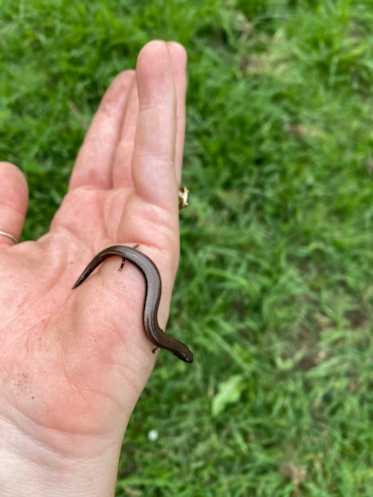Last week, I came across a special little critter in my garden in Berkeley.
I was digging a new garden bed for native plants along my back fence. The fence happens to share its boundary with a reserve, meaning we do come across interesting creatures that float in from time to time. Bush rats are our most regular visitors, though we also see a huge variety of birdlife, before my dog inevitably chases them away. A few times I have seen foxes and the reserve is always teeming with insect life as well as bats that populate the sky as evening descends. Lizards and snakes are common too, though unfortunately we mostly see the latter when they’ve been guillotined by the council lawn mowers.
As I was excavating the soil, I accidentally excavated a small skink. I immediately knew it was different to the usual garden skinks due to the apparent absence of legs, but an obvious skink-shaped body. I gently picked it up and found four teensy legs ending in three teeny-weeny toes, along with a lovely golden belly. Squealing in delight, I called over my husband and my five and three-year-old to look at the marvellous discovery. I then took a quick picture before it launched itself off my hand and back into the wild with its diminutive but surprisingly strong legs.
I have come across legless lizards before but until my research this week, I didn’t realise that the legless and nearly-legless lizards are two very distinct groups. Legless lizards look very snake-like with the absence of any obvious limbs, though most still retain eyelids and ears, unlike snakes. The lizards and skinks with reduced legs have visible legs that still retain some function in locomotion. So, my google search for ‘legless lizards of the east coast Australia’ did not return any lizards that had dinky little three-toed legs. Eventually, I found the little guy with a search of ‘small-legged skink east coast Australia’.
This less-than-scientific terminology led me to the species name Saiphos equalis, a monotypic species, meaning it is the only species with the genus Saiphos. I was astounded that the common name, three-toed skink, made no mention of the fun-sized legs.
As I read more about this burrowing skink species, I realised that its little legs were not its most interesting feature... by a long shot.
The three-toed skink has gained scientific attention for its bimodal reproduction, meaning the lizard can reproduce by laying eggs and through live birth. This is exceptionally rare, with only three of the 6500 species of lizard worldwide exhibiting bimodal reproduction. Two of these live in Australia, one of which lives in my garden! Wild.
They are common throughout the east coast of Queensland and New South Wales. The species has been observed to give birth to live young in the northern highlands of NSW, while the members that live in the lowlands surrounding Sydney lay eggs1. Then, incredibly, in 2019 researchers at the University of Sydney observed one three-toed skink female lay eggs and give birth within the same clutch of young2.
Though I couldn’t find any information on how the three-toed skinks of Wollongong reproduce, I hypothesise that since I live in the lowlands surrounding Lake Illawarra, it stands to reason that they would be of the egg-laying ilk. After the little lizard released itself, I indeed found an empty egg casing in the soil near where I found the skink. Case closed, if you ask me.
This species is a snapshot in evolution, a classic ‘missing link’ creature that helps us understand the evolution of pregnancy from egg-laying ancestors.
Pregnancy or viviparity is theorised to have evolved from egg laying, or oviparity, and this lizard represents a true intermediary between the two reproductive systems3. This transitory nature of the three-toed skink is even evident in the egg-laying members, as they retain the eggs inside the mother's body for at least 35 days, like a pseudo pregnancy, before the young hatch from the eggs in as little as five days.
The loss or reduction of limbs is also an example of evolution in action. That is, burrowing skinks do not need long legs to run away from predators on the surface like their full-legged cousins, and thus have gradually lost them due to a lack of environmental pressure on the function of their legs.
Three-toed skinks, despite their mundane common name, present a fascinating model for studying evolution and are rich with potential knowledge of the development of pregnancy from egg-laying ancestors.
How lucky are we to live with these incredible creatures in our backyards?
References
1. Smith SA, Shine R. Intraspecific Variation in Reproductive Mode within the Scincid Lizard Saiphos equalis. Aust J Zool. 1997; 45, 435-445. https://doi.org/10.1071/ZO97023
2. Laird MK, Thompson MB, and Whittington CM. Facultative oviparity in a viviparous skink (Saiphos equalis). Biol. Lett. 2019. 1520180827. http://doi.org/10.1098/rsbl.2018.0827
3. Foster CSP, Thompson MB, Van Dyke JU, Brandley MC, Whittington CM. Emergence of an evolutionary innovation: Gene expression differences associated with the transition between oviparity and viviparity. Mol Ecol. 2020; 29: 1315–1327. https://doi.org/10.1111/mec.15409






